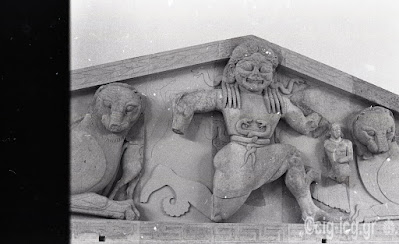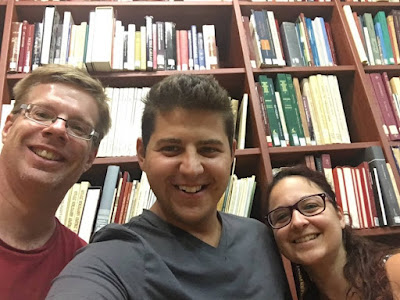Tuesday, August 30, 2016
Friday, August 26, 2016
Ancient Eleon from Above
Jordan also began experiments that have led us from aerial photos to three dimensional models based on drone data. In 2016 with a grant from the Friends of the Library at Wellesley College, Jordan was able to completely revise our aerial and digital photography program. In June this year he arrived with several very heavy suitcases containing two drones, a few computers, and a hand-held 3D scanner.
He and his team took daily aerial shots of all excavated areas, and photogrammetry software produced 3D models and photo mosaics that are geo-coordinated. This imagery records data at great precision, and offers an important complement to our traditional architectural drawings, digital measurements, and descriptions by trench supervisors. Drone photography also produced new video images of our entire site with our team in action. In addition we began a program of 3D scanning of excavated objects, carved objects and complete pots, which we look forward to sharing in publications, at conferences and on social media.With these new recording tools we are able to provide a much more engaging and lively presentation of our excavation. The enthusiastic responses from audiences show that our work is making an impact. We will of course continue and expand our digital imaging in 2017.
Brendan Burke & Bryan Burns
University of Victoria & Wellesley College
Tuesday, August 23, 2016
The Fred Winter Collection
Friday, August 19, 2016
Three years of fieldwork in the western Argolid
One of the interesting results of this year was the very low artifact densities. In 2014 we counted over 10,000 tiles and sherds per square kilometer surveyed; in 2015 that number was about 6,500, and in 2016, it was just above 2,700. In some ways, this wasn’t too surprising; a relatively large amount of our territory this year was taken up by long, high ridges oriented east-west that back up against the mountain range that separates the Inachos and Xerias river valleys. The ridges themselves were too rocky and removed from arable land to have sustained settlements in most periods. Rather, our sites this year tended to be located on small hills immediately above the course of the Inachos river, especially at “pinch points” where the valley narrows. On the east side of our survey area, this type of site was represented by Kastraki, where the ruins of a Classical farmstead, with the remains of its stone tower and a large millstone, were surrounded by a fairly dense scatter of sherds and tiles, including Late Roman material.
Many of our high density fields from the first two seasons were especially associated with Classical and early Hellenistic materials. Our 2014 season included the polis of ancient Orneai, which seems to have reached its maximum extent and intensity in these periods, and our 2015 season included a large settlement near Schinochori, probably a town associated with the Argive polity. In the 2016 season, however, only a scattering of Classical and Hellenistic artifacts were found on the left bank of the Inachos river. Thus, it may be that we have evidence for a boundary between the communities of the plain (surveyed in 2015) and those of the upper valleys (surveyed in 2014), manifesting itself as a largely empty space or borderland. This was not true in all periods, however: we found fairly consistent traces of Medieval and early Modern material in the 2016 season, especially on the slopes and hills above the river and its tributaries.In non-archaeological developments, we continued our little traditions of Saturday fieldtrips to sites in the area, of going to see a play at Epidavros (this time, a raucously hilarious performance of Aristophanes’ Ploutos) and of adopting a local stray puppy and taking it back to North America.
For more information on WARP, please visit our project website and blog at westernargolid.org!
Dimitri Nakassis
WARP co-director
Tuesday, August 16, 2016
The Fred Winter Collection
Friday, August 12, 2016
A Unique Opportunity to Explore My Cultural Roots - Report on My Global
For the past three months, I have had the privilege of filling the position as the Summer Intern with the Canadian Institute in Greece (CIG), offered through a joint agreement by the Institute and York University’s Global Internship program. The internship has proven to be a very enlightening experience, and the work assigned to me has amongst others, allowed me to sharpen my organizational skills and broaden my knowledge of the field of archaeology. Living in Athens as a local has been truly unique, as the vibe of Athenian life is very positive and uplifting. Being a major cultural centre with a rich past, many cultural activities exist around the city, and I was able to take advantage of visiting ancient ruins and museums. The internship position holds significant value to me, as I am of Hellenic descent, and have a deep appreciation for Greek language, culture and history. Being granted the opportunity to apply my Modern Greek language skills and fuse some of my academic interests with a practical work experience has given me a rewarding feeling.
In particular, my language skills proved incredibly useful for completing the institute’s archival project, which encompassed the majority proportion of my internship duties over the summer. Alongside the archival work, I was assigned other duties at the institute consisting of updating CIG membership database, entering new/renewing member names and contact information to the CIG database and delivering invitations to and picking up items from different institutions and government offices. This was particularly enjoyable as I was able to incorporate my daily exercise component as well as have the opportunity to explore various areas of Athens on foot. Perhaps the most rewarding task throughout my internship at the CIG was the ability to meet many academics and members of the tightly-knit archeological community in Athens. I had the opportunity to represent the Canadian Institute when partaking in other foreign school gatherings, including annual open meetings and lectures, and interact with many individuals at various receptions. Further, I was fortunate enough to be present during the CIG’s annual open meeting and the 2016 Colloquium entitled ‘From Maple to Olive’, hosted by the institute to commemorate the 40th anniversary of the recognition of the institute as a foreign school by the Hellenic Ministry of Culture. During the annual open meeting, I assisted in preparing for the presentation and reception, and I was able to learn more about some of the recent findings of various ongoing projects being conducted under the CIG, as well as listen to an interesting lecture by Professor Margriet Haagsma, who presented her work on the ancient site of Kastro Kallithea. The colloquium was equally special, and was a great way for me to learn about all the projects that have been conducted by Canadian scholars during the institute’s history. This was incredibly valuable to me as I had been archiving all such the projects and had the chance to meet the various directors and participants of each project. Through the presentation of each speaker’s paper, I gained a deeper understanding of the aims, work, and results of each project.
Over the course of the internship I was also able to do a bit of traveling, visiting different cities, monuments and museums. Particularly, around Athens I was able to visit the Acropolis, the Acropolis Museum, the Athenian Agora, Temple of Olympian Zeus, Mount Lycabettus, the Museum of Cycladic Art, the Benaki Museum, the National Archaeological Museum, the Numismatic Museum, the Byzantine & Christian Museum, the Greek Parliament, and was also able to visit the Peloponnese with the Director and Assistant Director of the Institute to see the ongoing survey project in the Argos area, the Western Argolid Regional Project. I was also able to take some time to travel to northeastern Greece, to Thessaloniki and Kavala, where my relatives live, and spend some quality time with them and explore the Byzantine Castle and the Archaeological Museum in Kavala.The global internship experience has been of incredible personal value for me, and it has afforded me the rare opportunity to work and experience daily life in a different country. I firmly believe that such endeavor has allowed for a unique addition to my skill set, being able to observe different methods of organization, take in different cultural and social interactions, traditions, and ways of life. I was able to heighten my level of awareness of the study of archaeology, learning about the function of the CIG, the work done under its auspices, and the role of foreign schools more generally, in the context of a collaborative effort with the Greek government to promote the study and preservation of Hellenic culture. Most valuable of all, I was able to exercise my proficiency in Modern Greek and learn more about my country of origin, being able to visit culturally significant sites and study findings from generations past. I would like to extend my gratitude to both York International for their extensive efforts in organizing and arranging opportunities for students to partake in such distinct experiences, as well as to the CIG, namely to the Director, Professor David Rupp, and Assistant Director, Dr. Jonathan Tomlinson for their warm hospitality and generosity for allowing me to be part of the CIG family. The experiences, friendships and memories I have made during this summer will always remain dear to me, and have immensely helped me in my growth both personally and academically.
Theodore TsilfidisYork University intern, summer 2016
Tuesday, August 9, 2016
Friday, August 5, 2016
A Roman at the Canadian Institute
My favorite place in Athens is Filopappos Hill, also called the Hill of the Muses, because it offers excellent views of Attica and the Saronic Gulf, well-signed ruins and some of the very best vantage points for photographing the Acropolis. It’s a fantastic place!
Also I visited the Archaeological site of Eleusis, Ancient Corinth and the ruins of Acrocorinth. The ruins of Acrocorinth are my favorite place and I was to climb to the top of the hill. The climb yielded a beautiful view of the Peloponnese, and was perfect for taking pictures.
I would like to thank David Rupp, the Director of the Institute, and Jonathan Tomlinson, the Assistant Director, for the opportunity to conduct my internship at the CIG. I would also like to thank my colleague, York University intern Terry Tsilfidis.
Claudia Tozzi
Erasmus intern, summer 2016





























